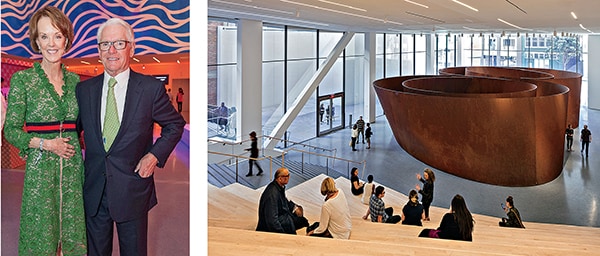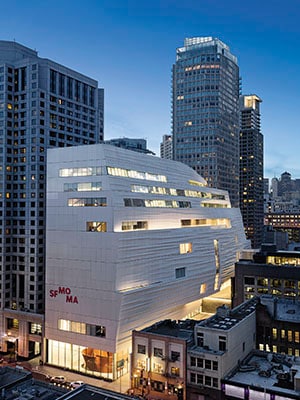
The San Francisco Museum of Modern Art: The city's new masterpiece
Thanks to a handshake deal between billionaire Charles Schwab and Gap founder Donald Fisher, SFMOMA is the envy of the art world
In 2007, Donald Fisher, founder of Gap, offered his enormous contemporary art collection to San Francisco, proposing to build a 100,000-square-foot museum in the historic Presidio. Featuring more than a thousand paintings and sculptures by blue-chip artists, including Andy Warhol, Ellsworth Kelly and Richard Serra, the collection was admired by art experts who had visited Gap’s San Francisco headquarters. But local preservationists were loath to see a boxy modern museum amid the Presidio’s 19th-century army barracks and waged war with Fisher for two years.
The philanthropist surrendered. He withdrew his offer, provoking rumours that his art might go to Oakland, or even St Paul, Minnesota. But billionaire investor Charles Schwab had other ideas. A close friend and business associate of Fisher’s, Schwab was also chairman of the San Francisco Museum of Modern Art (SFMOMA). “I started having many conversations with Don to convince him to bring his collection to SFMOMA,” Schwab recalls. The conversations took on greater urgency as Fisher was coping with terminal cancer. A handshake deal was made just days before his death in September 2009.
Nearly seven years later, as a vastly expanded and reimagined SFMOMA—now the largest modern art museum in the US—reopens its doors, Schwab’s intervention is viewed as a masterstroke. “Don trusted Chuck,” says Neal Benezra, SFMOMA director. “I’m quite certain that Don’s knowing that Chuck was committed to the Fisher collection and the growth of the museum allowed him to have confidence at the end of his life that his collection would be in great hands at SFMOMA.”
Schwab’s commitment to SFMOMA dates back to the 1960s, when he was just getting started in business and the fledgling museum occupied rented space in the War Memorial Veterans Building. “I started visiting with my children,” he says. “Growing up where I did [in Santa Barbara], I hadn’t had much access.” Following his $55 million sale of Charles Schwab & Co to Bank of America in 1983, Schwab had the financial resources to support the museum more directly, and his commitment only became stronger after he orchestrated a management buyback and IPO of his eponymous corporation in 1987. He soon went to work raising funds for a new SFMOMA building, teaming up with Don Fisher (who was already a museum trustee).
Designed by the Swiss architect Mario Botta and located in the South of Market district, the 225,000-square-foot museum opened in 1995. Almost immediately, Schwab and Fisher set out to find great art to fill it. They had a natural rapport, which they had bolstered by serving on each other’s corporate boards. “Our shared quest for contemporary art was an important part of the relationship,” Schwab says. Adventures together included a jaunt to Japan. “We went to buy art from a Japanese bank that had a vault full of art that had been securing debt,” he recalls. “A lot of the art we collected on that trip would go to the museum.”

Talk to Chuck: Charles Schwab (with wife Helen at the SFMOMA ball) landed Gap founder Don Fisher’s art collection for the museum for a century. Right: Richard Serra’s ‘Sequence’
Of course, landing the entire Fisher collection for SFMOMA was a deal of a different order. By agreement with the Fisher family, the museum will hold the collection in trust for at least the next century and must fulfil a number of requirements, such as a dedicated exhibition every decade. As Schwab explains, “Don had two very clear things he wanted to accomplish with his collection: To show the art regularly and to keep the collection together.”
And 225,000 square feet weren’t going to suffice—the scale of Fisher’s collection alone warranted more space. Together with Benezra, Schwab started interviewing architects about expanding SFMOMA.
They talked to nearly 40 firms—including Diller Scofidio + Renfro and Foster + Partners—before settling on the relatively obscure Norwegian firm Snøhetta (then best known for designing the Oslo Opera House). “We became convinced that they weren’t about a signature look but would listen and try to establish a building that would accomplish our goals—to be more open, more accessible,” Schwab explains.
The architects came up with a design that featured multiple entrances, free public exhibition spaces and visibility of art from the street, enfolding the post-modern Botta building within a sleek new ten-storey edifice. With a model packed in Benezra’s trunk, Schwab and he, along with Robert Fisher (one of Don’s sons and museum president), began making house calls to philanthropists and business leaders, seeking to raise $610 million. Schwab was tireless—and highly persuasive. “People have so much respect for Chuck that it’s really hard to say no to him,” Benezra notes.
The deep wells of support were spectacularly on view in early May at the SFMOMA Modern Ball celebrating the museum’s reopening. Among the attendees were tech royalty such as Twitter co-founder Evan Williams, Instagram co-founder Mike Krieger, Zynga co-founder Mark Pincus and Yahoo CEO Marissa Mayer. They cavorted through galleries filled with newly unveiled paintings by Jackson Pollock, Francis Bacon, Jasper Johns and Brice Marden, and contributed an additional $2.5 million to the museum’s education programme.
For Schwab, the strong tech world support for the new SFMOMA seems only natural, given that contemporary art is so much about innovation. In fact, the interest of Silicon Valley’s titans mirrors his own passion for contemporary art. “It is similar to how I think about business,” he says. “They’re both the art of the possible.”
(This story appears in the 30 November, -0001 issue of Forbes India. To visit our Archives, click here.)





